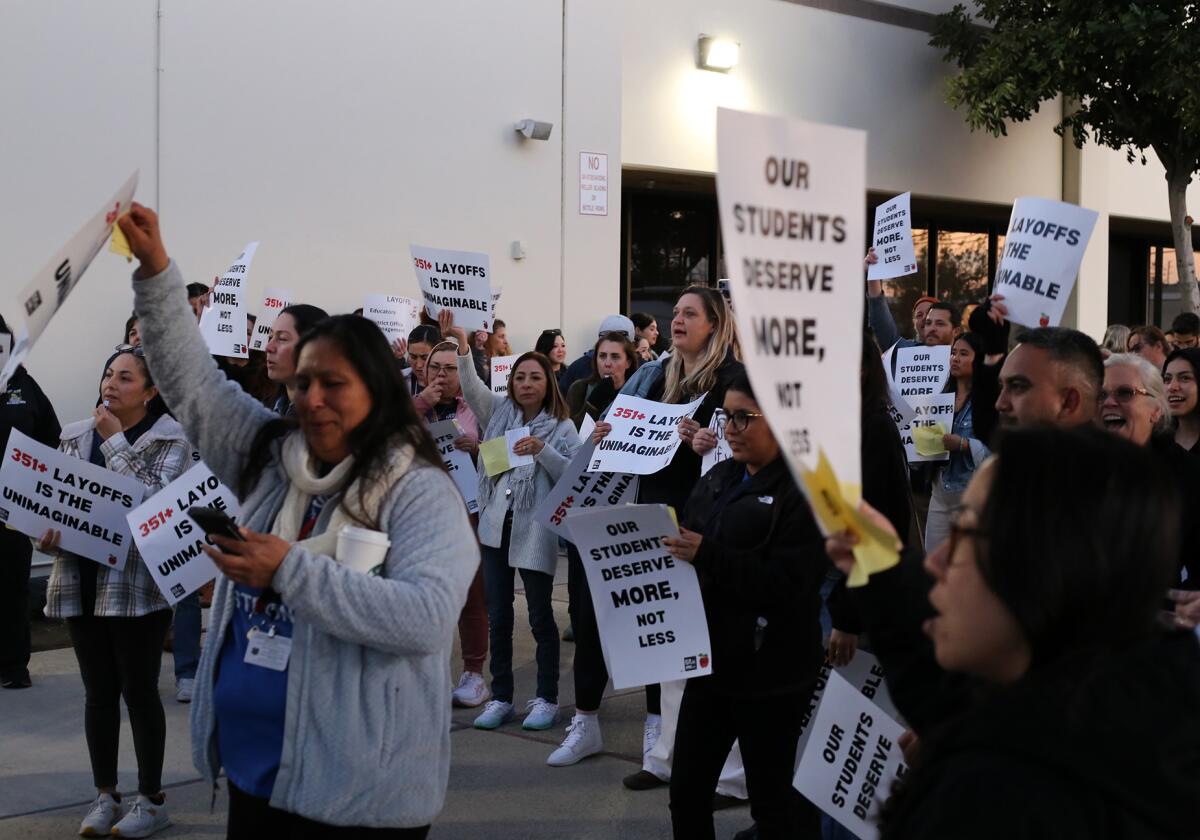Apodaca: California population decline reveals harsh reality for education funding

- Share via
The decline in K-12 public school enrollment across California, as predicted, is forcing many school districts to make some painful decisions.
We saw an example of this recently, when Santa Ana Unified School District, facing a $154-million budget deficit and 28% fewer students than a decade ago, announced it would lay off about 262 employees, including teachers, counselors and other staff members.
Decreasing enrollment isn’t the only reason for Santa Ana Unified’s budgetary bind. Most acutely, as with other districts, it is grappling with the loss of federal COVID bailout funds, which ended last fall.
Still, there’s no question that the steady loss of public school students is putting Santa Ana Unified, and most districts throughout California, in a tough place financially.
Public schools are funded through a mix of federal, state and local money, but in California the state by far accounts for the largest share of education dollars.
Those state funds come from income taxes, property taxes and sales taxes, and a relatively tiny proportion from the state lottery.
The number of students in a district influence how much state funding it receives. That’s why enrollment losses often lead to reductions in the amount of money allocated to each district by the state.
The picture can get a bit complicated, though. Under California’s Local Control Funding Formula, which began in the 2013-2014 school year, some districts throughout the state receive additional funds if it’s determined that they have a large share of “high needs” students.
And a small number of the state’s public school districts are so-called “Basic Aid,” or “Community Funded” districts, meaning that they rely more heavily on revenue collected from local property taxes to cover their expenses. Newport-Mesa Unified School District, for example, is a Basic Aid district.
Despite such exceptions, however, most districts are struggling with the financial pressures tied to declining enrollment.
Last fall, the state Department of Finance reported that the number of public school students had fallen for the seventh straight year.
There are many reasons behind the slide. Enrollment took a big hit during the COVID pandemic, and some students never returned. Some moved out of state, while others migrated to private education or homeschooling.
California’s high cost of living — particularly the state’s stratospheric housing costs — are cited as a contributing factor. And critics from both the right and left of the political spectrum have taken aim at what they see as misguided priorities, both financial and social.
But the biggest factor, many analysts say, is declining birth rates, which have steadily fallen in the United States over the last 15 years. The Centers for Disease Control and Prevention recently reported that the total national fertility rate was 1.6 children per woman, far below the 2.1 rate needed to naturally maintain the population.
Simply put, that means we have fewer kids entering, or who will enter, our schools. Some experts have referred to this as “a demographic cliff.”
Growing enrollment in transitional kindergarten is mitigating the overall declines in enrollment numbers, at least somewhat. But the long-term picture isn’t great.
The state Finance Department projects that in the coming decade “if current trends in fertility and migration hold,” total enrollment will fall further.
The federal government projected California will lose another one million public school students by 2031.
The hits will affect different schools and their districts in different ways, and each one will have to navigate a path forward to maintain solvency without, hopefully, sacrificing educational goals. It won’t be easy.
Last year, Anaheim Union High School District announced plans to lay off more than 100 teachers amid plummeting enrollment, but it later backtracked and instead made other cutbacks.
Other districts throughout Orange County are also considering closing schools or consolidating campuses.
For instance, Saddleback Valley Unified School District plans to close San Joaquin Elementary this year, and Anaheim Union High School District is closing Orangeview Junior High and shifting the middle school students to Western High School.
In announcing its plan to jettison some employees, Santa Ana Unified Supt. Jerry Almendarez said in a statement, “Staffing adjustments are part of a long-term strategy to align our resources with student enrollment trends and financial realities.”
That rather dry statement doesn’t mask the harsh reality that district administrators and school boards are increasingly faced with excruciating choices.
It’s terrible that valued teachers are being laid off, and parents are understandably upset at the prospect of losing their beloved community schools.
The uncertainty and disruption alone are difficult to cope with.
Unfortunately, we must brace ourselves because we’re sure to see more tough times for public schools in the coming years. More strained budgets, more layoffs, more school closures.
In a perfect world, all of our public schools would be assured of a steady, predictable and sufficient level of funding to ensure that all students have access to a quality education. But that’s not the world we live in, and the impact of population changes provides us with a stark reminder of that fact.
All the latest on Orange County from Orange County.
Get our free TimesOC newsletter.
You may occasionally receive promotional content from the Daily Pilot.




